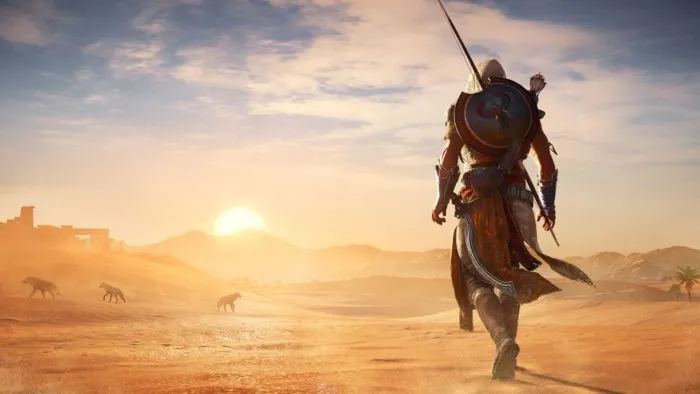Finally Doing Away With Eagle Vision

Eagle Vision has been a tried and true mechanic of the Assassin’s Creed series since its beginning, but it’s one that definitely needed to go by the wayside. Since its use in the first Assassin’s Creed, a style of Eagle Vision has been used in countless games, causing it to become a bit of a tired mechanic in the series. Using the vision to track down an enemy, mark him, then assassinate them, has been done time and again throughout the series. Basically, the mechanic stopped being engaging and just felt like busywork inserted into each game.
Assassin’s Creed Origins takes the step of completely doing away with Eagle Vision, opting for a new system that’s more like scouting. By calling Bayek’s eagle, Senu, you can take control of the bird, flying above the areas you want to investigate. From the air you’ll be able to scout areas, highlighting enemies and points of interest that Bayek himself will then be able to see. A similar mechanic was used in Watch Dogs 2, letting you use a drone to scope out areas and tag enemies. Still, it’s a step that Assassin’s Creed needed to take, leaving a tired mechanic behind in favor of something newer.
Totally Revamped Combat

By far the biggest change in Assassin’s Creed Origins is the completely overhauled combat. Past games in the series worked on a fairly simplistic, timing based combat system that gave you access to multiple weapons, accessories, and items. While Origins still has plenty of variety in what you can use, its combat has switched to a heavier, more hitbox oriented approach. It’s a much more complex system that takes into account weapon ratings and stats, as well as what area/limb you hit on an enemy. Along with a closer camera that sticks to your character, rather than encompassing you and the enemies, Origin’s combat feels much more tactical and methodical. It plays much more RPG-like in battle, with damage numbers playing a role as well as they bounce off enemies with each strike.
It’s about learning how to use each weapon in the game, how to go up against each enemy, and how to properly exploit their hitbox. In this way it’s sort of like Dark Souls crossed with Assassin’s Creed, although it definitely has an identity of its own and isn’t anywhere near a copy of Souls combat. Regardless, if you didn’t quite enjoy combat in past AC games, Origins has a fresh system for you to hop into.
More Action-RPG Than Before

Ubisoft has taken the extra time with Assassin’s Creed Origins to not only give us a new story and starting point for the series’ lore, but also redefine a bit of what the core gameplay of the series is as well. With Origins we see an Assassin’s Creed that’s much more of an action-RPG than its predecessors, weaving in new systems alongside staples. Combat, of course, has more RPG elements now, but it’s also the equipment and crafting system, as well as a leveling system.
That’s right, Origins has XP and levels that you gain as you battle enemies and complete objectives. This doesn’t mean the game is going straight up RPG, but as you gain levels you can unlock skills on one of three skill trees – Seer, Warrior, and Hunter. Each tree focuses on a specific play style, but you can mix and match abilities to customize your gameplay experience. Enemies have levels too, and if you find yourself at level 10 going up against a level 30 enemy, you probably won’t come out unscathed. Equipment comes with different stats, and there’s a wide array of armor and weapons to equip. Loot is picked up based on rarity, with Legendary being the the tier you want to get the most. A brand new crafting system also requires you to collect resources from around the world in order to create new weapons and items. The heart of Assassin’s Creed Origins is the same as before, but you’ll be walking into a much deeper RPG experience this time.
Gorgeous Open World

Assassin’s Creed has certainly been a slouch in the graphical and artistic style departments, but Origins really kicks things up even from what we’ve seen. Ancient Egypt might just be the most gorgeous, sprawling location we’ve seen yet, even beating out France in Assassin’s Creed Unity and the Caribbean in Assassin’s Creed IV: Black Flag.
The extra time clearly afforded Ubisoft the chance to really dig into the game and create a massive open world to explore, and explore you can. Even more than past games in the series, you’ll have the chance to run around on foot, and horseback. There’s plenty to discover out in the deserts of Egypt. You’ll find wild animals to tame and fight, tombs to explore, and a myriad of sidequests that pop up. NPCs are scattered all throughout the world and have their own priorities and tasks, making the world feel alive and lived in. Most things just seem to fit better, particularly how sidequests are worked into the world, feeling more organic and less arcadey, like in past AC titles. It’s clear that the team really wanted to improve this aspect of the series, and even took inspiration from some recent open world titles like The Witcher 3: Wild Hunt.
Better Quest Variety

In addition to just being inserted into the game more organically, the extra time has allowed sidequests in Assassin’s Creed Origins to have more variety. Most sidequests in past games revolved around collecting certain materials/objects, or hunting down specific targets. New entries improved on this formula adding new and interesting things, but Origins probably does the best job of it.
Ancient Egypt is packed with things to discover and explore, a lot of which focus on the everyday life of the residents of Egypt. Bayek will interact with plenty of people, both unknown and famous. There’s also plenty to keep things varied, like stargazing events throughout the desert that detail Bayek’s history, and tombs to raid for treasure. At the same time assassination contracts are still in the game, but enemies are much more varied, with unique looks and skills, as well as a bit of story behind each. Of course, there’s also more to divert your attention, like strongholds to conquer and secret gameplay challenges to find. Basically, there’s more to see and do than ever before in Assassin’s Creed Origins, and some activities have more story attached to them than you’re used to.
More Focus on History

Assassin’s Creed has always had a fascinating way of playing with history, from the American Revolution of AC III to the French Revolution of AC Unity. Origins puts things farther back in history than we’ve ever been with Assassin’s Creed though, and the team has clearly done their research this time around. Being so far back in the past, certain parts of history remain unclear and unknown, but a post on the Ubiblog details some of the team’s efforts, “To represent these areas in the game, Durand says, the developers consulted Egyptologists and studied a wide variety of materials on ancient Egypt, including movies and comic books as well as historical texts and documentaries. Their research helped them move beyond clichéd depictions of Egypt, even going so far as to shape the unique topographies of the game’s vast deserts.”
A major character in Origins is Cleopatra and the main characters of the game, Bayek and Aya, interact directly with her, as well as Julius Caesar. Iconic moments in ancient history are portrayed through the game, and the depiction of Ancient Egypt Ubisoft has created tries to stick to reality as much as possible. The extra time the team took for research and history shines though, and there’s another small treat Assassin’s Creed fans will get early next year. Discovery Tour Mode puts the focus squarely on history, taking away combat and challenges, and letting players roam around Ancient Egypt guided by virtual history lessons. They’ll learn about various things through Discovery Tour, like the mummification process, the construction of landmarks, politics, and more. It’s a great way to organize all that work the team put in on Assassin’s Creed Origins, and help give the game a second purpose as a learning tool.






Published: Oct 27, 2017 10:24 am